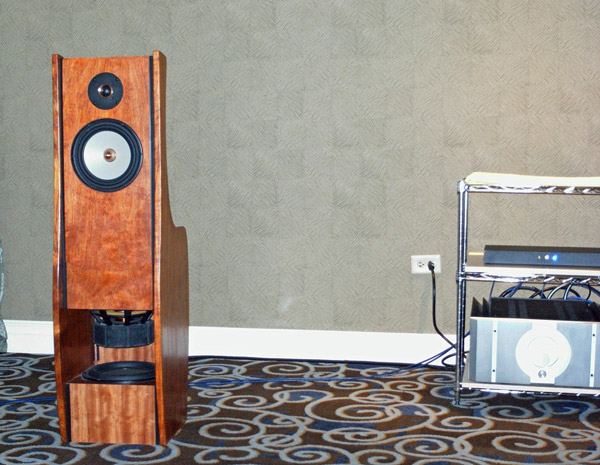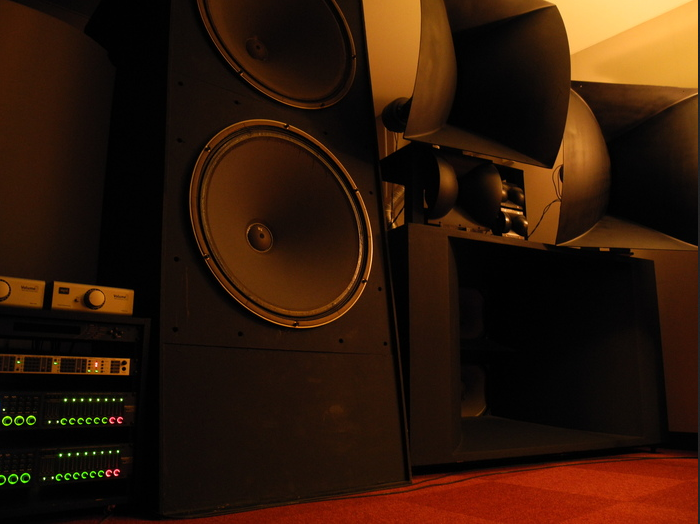Just wondering what the advantage is in using dual woofers vs a single per cab? Since in a dual set up the drivers see one half the volume each whether in separate chambers or not, doesn't the single driver set up trump the +3db dual due to better extension? TIA.
It usually comes down to the designers goals. Some designs use the 2nd woofer for baffle step correction. Sometimes it's to have a narrower speaker cabinet. Or some wish to have "Fast Bass" (Kind of a myth actually.) Could be for mentioned +3dB to match the efficiency of the other drivers in the system. Or it could be simple economics.
Mike
Mike
Last edited:
Just wondering what the advantage is in using dual woofers vs a single per cab?
GAIN.
Wired in parallel, the two drivers have +3db acoustic gain for the two woofers and +3db voltage gain for the halving of Impedance. Particularly useful to compensate for baffle-step loss.
For a similar output level this also means that the double driver grouping generally has lower non-linear distortion at higher freq.s..
PLUS - if a midbass solution for a floor-standing loudspeaker (up to about 450 Hz) and coupled near the floor - it can mitigate the amount of "nulling" created by "floor bounce".
There are problems as well:
1. potential combing at higher freq.s with a resulting poor linear performance at those freq.s..
2. lower output at lower freq.s for your effective "halving" of cabinet volume.
3. longer vents required to get more low freq. output because of your halving of cabinet volume (if using a bass reflex design).
4. reduced excursion overall - creating a lower sense of physical impact.
5. the resulting average Impedance might be too low for the amplifier it's paired with.
etc..
If the woofers are XOed low enuff (i rarely use them above a couple hundred hz) they can be mounted push-push, and if tightly coupled, you get active cancelation of reative forces significantly reducing the energy put into the cabinet walls giving less chance for panel resonance.
dave
dave
In physics, efficiency versus bandwidth is a fairly universal trade off. IMHO multiple woofers used domestically find usefulness with directivity, spatial issues such as MTM or with room modes, or force cancellation.
Conventional compensation of baffle step changes in implementation but will have basically the same acoustic issues either way.
Conventional compensation of baffle step changes in implementation but will have basically the same acoustic issues either way.
If you do a three-way, dual woofers may be mounted push-pull for less distortion.
These are open baffle, but they could be designed to be sealed or vented too.

A smaller three-way system.
An externally hosted image should be here but it was not working when we last tested it.
These are open baffle, but they could be designed to be sealed or vented too.

A smaller three-way system.
If you do a three-way, dual woofers may be mounted push-pull for less distortion.
Less even order distortion.
dave
Dual woofers, so long as they're happy with the cabinet volume available, can put out 6dB more than a single woofer, while maintaining the same cabinet front width.
Sure, you could replace 4x 6" woofers with 1x 12" woofer for the same cone area, but the 1x12" will be twice the width, reducing SAF considerably.
Chris
Sure, you could replace 4x 6" woofers with 1x 12" woofer for the same cone area, but the 1x12" will be twice the width, reducing SAF considerably.
Chris
Just wondering what the advantage is in using dual woofers vs a single per cab?
Since in a dual set up the drivers see one half the volume each whether in
separate chambers or not, doesn't the single driver set up trump the +3db
dual due to better extension? TIA.
Hi,
All things being equal for a given box volume, reducing
efficiency by 3dB will give better bass extension. It is
a trade-off you make when you choose the drivers.
For a dual driver box you clearly use double the volume
you would for a single driver, so the bass extension is
the same as single driver, however a similar efficiency
single driver ideally suited to the larger box would
have deeper bass due to the larger box size.
rgds, sreten.
Indeed, but it would also stave off the effect of the baffle step for a further octave.twice the width, reducing SAF considerably
I'm not nearly as knowledgeable as some of the people who provided feedback here already, but I'll throw in my two cents as I'm going exactly through this now.
In my case, I'm looking for a solution for 80 to 400 or 500Hz with either a 12" or two 10", in a sealed box. To me, it's boiling down to the "sense of physical impact" mentioned above, and ability to mitigate the effects of baffle step loss, floor bounce, etc.
2 drivers allow for placement that can significantly mitigate baffle step loss by placing one woofer close to the floor and getting reinforcement from it. At least this is what I'm getting from modelling with Bagby's diffraction simulator.
Physical impact I think is a bit more ellaborated than just woofer Sd, or Vd for that matter. But granted, these are my thoughts - not confirmed by any of the gurus.
In my view, physical impact is likely correlated to the amount of air displaced. So I take Sd x displacement, where displacement is the modeled amount of displacement with my box at the crossover point to reach a given SPL. In my case I'm taking 105dB at 80Hz because that is as high as my subwoofers can work well. So I model displacement at 105dB and 80Hz with the given box. Surprisingly, with some 10" woofers, such as the Beyma 10G40 I get higher displacement than from using a single 12" woofer (depends on the woofer, of course) in such a way than the volume displaced by 2x10" is larger than 1x12". Since both 10" drivers are being displaced less than 30% of Xmax I think distortion is being kept very low anyways. So maybe this approach, with the right drivers, allows for the best solution overall.
Unfortunately all this is inly from a conceptual point of view as I have not come to the construction phase yet.
In my case, I'm looking for a solution for 80 to 400 or 500Hz with either a 12" or two 10", in a sealed box. To me, it's boiling down to the "sense of physical impact" mentioned above, and ability to mitigate the effects of baffle step loss, floor bounce, etc.
2 drivers allow for placement that can significantly mitigate baffle step loss by placing one woofer close to the floor and getting reinforcement from it. At least this is what I'm getting from modelling with Bagby's diffraction simulator.
Physical impact I think is a bit more ellaborated than just woofer Sd, or Vd for that matter. But granted, these are my thoughts - not confirmed by any of the gurus.
In my view, physical impact is likely correlated to the amount of air displaced. So I take Sd x displacement, where displacement is the modeled amount of displacement with my box at the crossover point to reach a given SPL. In my case I'm taking 105dB at 80Hz because that is as high as my subwoofers can work well. So I model displacement at 105dB and 80Hz with the given box. Surprisingly, with some 10" woofers, such as the Beyma 10G40 I get higher displacement than from using a single 12" woofer (depends on the woofer, of course) in such a way than the volume displaced by 2x10" is larger than 1x12". Since both 10" drivers are being displaced less than 30% of Xmax I think distortion is being kept very low anyways. So maybe this approach, with the right drivers, allows for the best solution overall.
Unfortunately all this is inly from a conceptual point of view as I have not come to the construction phase yet.
Thanks so much for the attention. I think all the info I need. I have a recipe for a 4 way JBL project which will include 2245, 2206, 2390, and 2405. Essentially a franken-4345. But I have 4 2245s. Total main cab volume will be 10cu. whether I use two 2245 per or not. Isobaric appears to be a way to maximize performance while reducing cab size albeit at the expense of efficiency. I guess the question is how much can the cab size be practically reduced and will performance be enhanced enough to make it worthwhile? I'm not too concerned about efficiency as these will be fully active. In you guys' opinion, is it worth the trouble or would you just go with a single 2245? They are destined for my living room, 17'X17', open on one side to the dining room.
I should add I'll probably cross them over at something like 150hz?
I should add I'll probably cross them over at something like 150hz?
"Less even order distortion."
Oops, I forgot to throw that in.
With my double 15 design it also reduces 3rd harmonic for 80hz and above as the plenum acts like a low-pass filter as well.
" 2206"
See if you can find the 2204, it sounds better for hi-fi than the 2206.
Oops, I forgot to throw that in.
With my double 15 design it also reduces 3rd harmonic for 80hz and above as the plenum acts like a low-pass filter as well.
" 2206"
See if you can find the 2204, it sounds better for hi-fi than the 2206.
Last edited:
is it worth the trouble or would you just go with a single 2245?
might try both.
nothing has to be permanent ...
``````````````````````````````````````
this man has 2206's.
horn loaded -

he is continually changing things however -
??????????? < his website
Attachments
"Less even order distortion."
Oops, I forgot to throw that in.
With my double 15 design it also reduces 3rd harmonic for 80hz and above as the plenum acts like a low-pass filter as well.
Is it a good idea to seek this with midbass woofers in the range of 80-450Hz?
Are you referring to opposing woofers, such as the BMF-1 uses, or a different configuration? I believe the BMF-1 has the opposing woofers working below 80Hz so directivity is not a big deal. Or maybe something like the Linkwitz LX-521?
My starting point is two midbass woofers facing front, which likely defeats any posibility of cancelling each other's distortion.
- Status
- Not open for further replies.
- Home
- Loudspeakers
- Multi-Way
- Why dual woofers?
